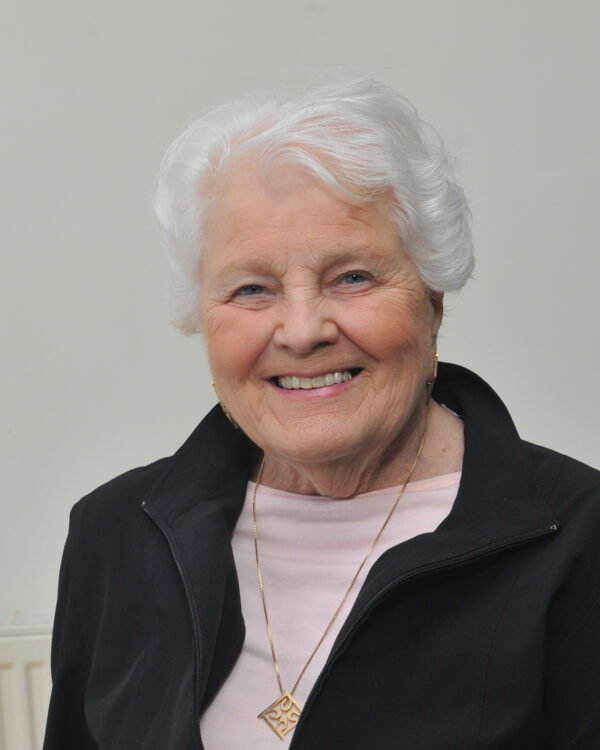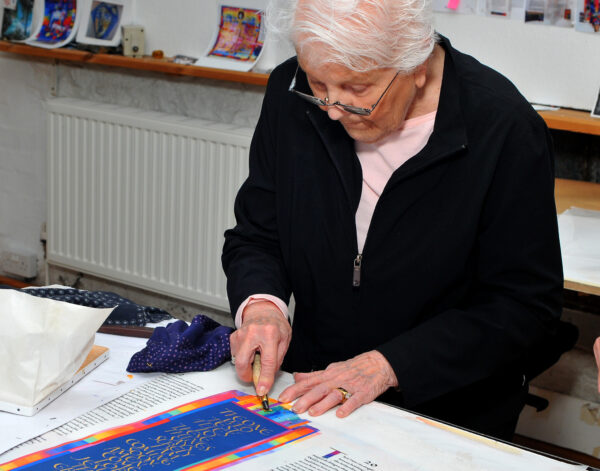The Mother of The Saint John’s Bible: Alice Joan “Jo” White
It is only appropriate that the first installation of the “Women of The Saint John’s Bible” series should begin with the mother of this creation. Gifted with tenacity and the rare ability to actualize grand, abstract ideas into existence, this work of sacred art would not exist without her.
On a windy November day in the final years of the 20th century, renowned calligrapher Donald Jackson and Father Eric Hollas, OSB of Saint John’s Abbey in Collegeville, Minnesota sat in a Chicago restaurant during the lunch hour. The pair had just finished a joint presentation on calligraphy at the Newberry Library in Chicago. Unknown to Fr. Eric Hollas, Jackson had a lucky charm of sorts rumpled inside his pocket a treasure whose other half was in the purse of an immaculate organizer and connector of people, Alice Joan “Jo” White.
This treasure was two halves of a two-dollar bill, with that day’s date November 27, 1995 signed on it in fiery ink from a red, felt tip-pen. “You take one half and I’ll take the other, and when this thing comes to fruition, we’ll put them together,” White had told Jackson just one hour earlier in a hotel lobby.

Alice Joan “Jo” White was a courageous woman with innumerable talents. For all the roles she played throughout her life, she is perhaps best described as the sun in a solar system of incredible passion and artistry. On the day that she split this two-dollar-bill in half, she sent Donald Jackson, Senior Scribe and Illuminator at the Crown Office in the House of Lords and Artistic Director of The Saint John’s Bible (though the second title depends on the outcome of this very lunch meeting) to discuss the possibility of a Benedictine Abbey hand-scribing an entire Bible for the first time since the invention of the printing press.
“The Saint John’s Bible was a far-off dream at that point. Father Eric didn’t know I had that half-dollar bill in my pocket and Jo had it in her purse,” said Jackson. “Jo put my dream into the view of the people who could make it happen. It was a lifetime dream for me, but if it wasn’t for her, that’s all it might well have remained.”
Jo White was born in Prior Lake, Minnesota in 1930 to parents Frank and Margaret Suel, who were farmers and themselves came from a long lineage of farmers. White had six sisters, which just might be where she got her incredible character and heart of gold. Her young adult life was dedicated to teaching art, building a family, and raising her nine children. During this time, she built an incredible, sturdy spirit and capacity for making things happen.
“She used to say that, as a ‘Minnesota housewife,’ and having brought up nine children, she learned how to organize things the hard way,” said Jackson. “Once the kids grew up and were independent, the world was her oyster. She had confidence in herself as a woman who brought up a large family, who had put them first, and she now wanted to dedicate herself to other things.”
White’s children have many memories of their mother painting, crafting, making clay, building two-story treehouses, and reading. With little to no experience to speak of, White even designed and sewed her daughter, Sara Thull’s wedding dress. But what really lit White’s fire happened when the majority of her children reached adolescence. White decided to take a community calligraphy class. From that very first day, she was hooked.
“One thing about Mom is she loved Dietrich Bonhoeffer,” said Jo White’s son, Bill White. “She loved quotes. Calligraphy was this perfect intersection of loving quotes and loving deep reflection of people expressing themselves, for example, the Prayer of St. Thomas More, which she calligraphed for my dad. She was on this amazing collision course with calligraphy and the lettering arts and it became her median. She calligraphed so many quotes that stuck with her, such as the famous John Adams one, ‘I must study politics and war so that my sons may have liberty to study mathematics and philosophy.’”
Jo White: A Dreamer and a Doer in One
White first met Donald Jackson in 1974, when Jackson was leading a calligraphy workshop in New York City. During these days, European calligraphy was in full revival. As a consequence, Jackson’s schedule was quite busy with workshops such as this.
As one of the foremost calligraphers in the world, his credentials are enough to make anyone timid. Yet, in the middle of Jackson’s lesson and with 20 students fervently basking in his every word, White strolled into the room and walked directly up to Jackson. She said, “Hi, I’m Jo White. When are you coming to Minnesota?” and shook his hand. Before the conversation came to a close (with twenty students still watching), Jackson had given White his word that he would come to Minnesota. “She was a very hard woman to say no to,” said Jackson. “In fact, almost impossible.”

Jackson honored his word in 1977. By this time, White had founded The Colleagues of Calligraphy, a Twin Cities, Minnesota-based organization for scribes and curious future artists to unite in their shared interest in the craft of calligraphy. With her nine children grown and more than enough powerhouse nature to spare, White dreamed of making the organization international. So, she did.
The Colleagues of Calligraphy hosted the first international calligraphy conference at Saint John’s University in Collegeville, Minnesota that year, just one year after its founding. Though she completed her higher education, a Teacher Training Certificate, from Mankato State in 1950, White had attended dances at Saint John’s University while she was a student at Shakopee High School (there was no high school in her hometown of Prior Lake, which is about 90 miles Southeast of Collegeville, until 1951) and had been enamored with the University ever since. In fact, many of her children went on to attend Saint John’s University or the College of Saint Benedict, the University’s sister school.
“We always had a relationship with Saint John’s and Saint Benedict,” said White’s son, Jim White, “so she secured a dormitory and got a gymnasium, but she knew that she had to have a world-class calligrapher in attendance. She narrowed in on Donald Jackson, who, at the time, was the Scribe to the Queen of England. To convince an artist of this caliber to come to Collegeville, Minnesota for a calligraphy seminar was just unbelievable.”
White got what she wanted. Donald Jackson was the conference’s keynote speaker, which turned out to be the calligrapher’s very first introduction to Saint John’s University.
“Jo loved calligraphy and she did whatever she could to bring that love to others,” said Jackson. “She invited experts from around the world and encouraged them to meet. She also put aside her own ambition to improve her calligraphy largely in order to do this on my behalf and everybody else’s behalf. Once you do that, once you follow your dream and you do it for its own sake, you end up realizing that you are not in it alone. If you throw a dream out there, it repays you in more ways than you could have imagined, but first of all, you have to be open to it happening.”
Jackson recalls one memory of White when he was part of a calligraphers tour in Europe, which White organized. “Somehow, she got us into the Vatican and we ended up drinking whiskey with the Prefect of the Vatican,” said Jackson. “She just opened her purse and out came a bottle of whiskey. The Prefect said, ‘Oh, I don’t have any glasses.’ No problem for Jo. She opened another part of her purse and out came 12 miniature glasses. We all started swigging whiskey. She could get over people’s doorsteps and win anyone over.”
This included Jackson, who White has convinced to participate in a fair amount of adventures ranging from silly to unprecedented to strenuous, such as waking up at five o’clock on a frigid New York winter’s morning to appear on the Today Show or dressing up in costume alongside a serious academic at an equally highbrow conference White had organized at Saint John’s.
“She ended up convincing the senior director of Sotheby’s auction house in London to appear dressed in a leprechaun’s outfit to deliver a speech at a very important conference,” said Jackson. “We thought, ‘If Jo thinks it’s a good idea, it probably is even though we don’t think it is, so we’d better do it. In any case, we’re too afraid to say no.’ I ended up dressed as a punk rocker monk and of course she was right, it certainly got people’s attention.”
White collected admirable collections and accolades throughout the years, mostly because she was so unafraid of taking a first step into uncharted territory.
For example, when she began organizing a series of exhibitions for Jackson’s work across the globe, she did not know one single museum director or curator. By the time the exhibition tour was complete, White had made sure Jackson’s work was exhibited in 13 of the top museums in the world, starting in Minneapolis, Minnesota, and with stops in Hong Kong, China, Scandinavia, and more.
A Matriarch’s Legacy
White’s efforts for The Saint John’s Bible were recognized by Saint John’s University when she received the University’s highest honor award, the President’s Citation and Medal in June 2017. White will be remembered by the masses as the Mother of The Saint John’s Bible, but, to all of the individuals to whom she is a biological matriarch or fictive kin, she is remembered for her boundless resilience, artistry, and unwavering belief in those she loved. In the midst of her grand endeavors, she remained an incomparable mother and grandmother to her nine children, 22 grandchildren, and 13 great-grandchildren.

“She would not be stopped by a lot of the things in our society that would typically stop a woman,” said Jane Schneeweis, White’s daughter. “That’s what she taught me. You try to stay and deal and work it out, and when you can’t, then you go around them and move on.”
“She was very firm and fair,” said Thull, White’s daughter. “If I was going through a tough time, Mom would say, ‘You’re going to come out on the other side. I will help. I’ll be here. But you’re going to do the work.’ She knew that would make us strong, and it did.”
White and Jackson united the halved two-dollar bill in 1998 when Jackson signed the commissioning of The Saint John’s Bible. Throughout the years, Jackson put the finishing touches on many vellum pages at White’s desk in her then home in Burnsville, Minnesota, before delivering them to Saint John’s. White’s legacy will live on for centuries in the pages of The Saint John’s Bible and in the hearts and minds of each and every person who has been or will be touched by the work of sacred art and Scripture.
The Saint John’s Bible: Crafted with the most sophisticated tool of our time, human hands
To read more stories similar to this one, visit the Heritage Program blog and subscribe to the monthly e-newsletter, Sharing the Word.


